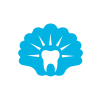Pediatric Orthodontics
Pediatric orthodontic treatment provides diagnosis and treatment of problems in children’s teeth and jaw structures. Thus, children have a healthier mouth structure. Crooked and incorrect tooth alignment that may occur in the mouth is prevented. In orthodontic treatment applied to children, 2 types of apparatus are generally used. These are extraoral devices and intraoral devices. Extraoral appliances (such as jaw braces) are generally used to correct skeletal problems or to support the appliances used in the mouth. Intraoral appliances are of 2 types: removable appliances (palates) and fixed appliances (braces, brackets).
There is no orthodontic treatment under the age of 7, except for extreme conditions such as cleft lip. Depending on the encountered and predicted disorder, treatment applications start from the age of 7. If only fixed braces treatment is to be performed, all permanent teeth are expected to erupt. Permanent teeth complete their eruption at the age of 12-13.
Appliance is the name given to the devices used in orthodontic treatments. These fixed and removable devices apply pressure on the mouth and jaw with their screws and springs. The appliance, which eliminates many problems in the mouth, especially the disorder of the upper and lower jaw, is one of the best treatment methods in this field.
The problem of jaw stenosis or jaw width in children can be solved with jaw appliances until adolescence. After puberty, jaw problems may require surgery. For this reason, early diagnosis and early intervention are very important.
With early orthodontic treatment, the width of the upper and lower tooth curves can be regulated and space can be gained for permanent teeth. Permanent tooth extraction can be reduced as much as possible, the risk of impacted teeth is reduced, habits such as finger sucking can be prevented and abnormal swallowing and speech problems can be eliminated.
Due to some genetic conditions, children may have jaw disorders or crowded teeth problems. For example; when the child receives a narrow jaw gene from the mother and a large tooth gene from the father, this may cause jaw disorders in the child. From the age of 7, orthodontic examination is necessary for children. Every early treatment will prevent more difficult treatment processes in the future.
